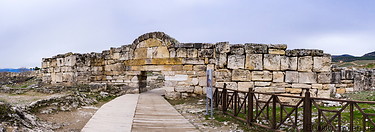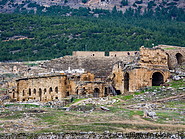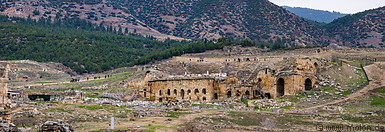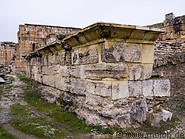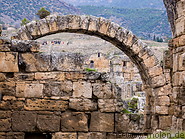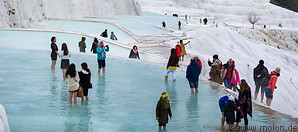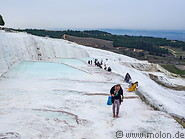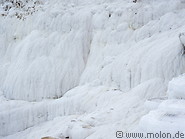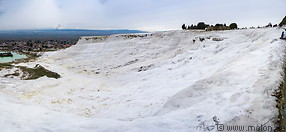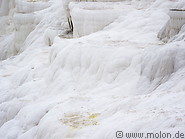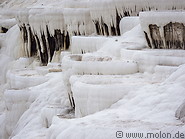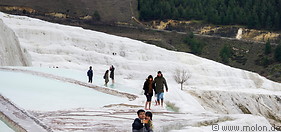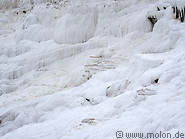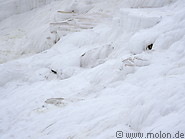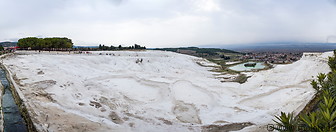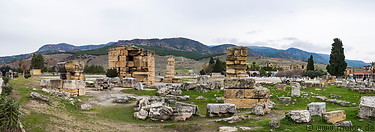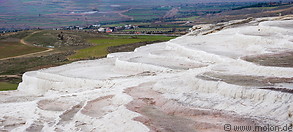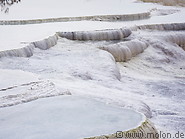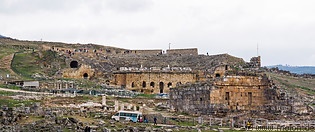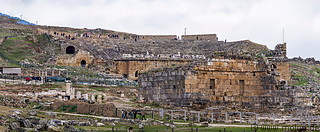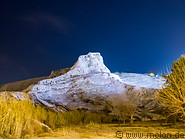Pamukkale is actually a combination of two sites:  the well-known white rock terraces with water pools (Pamukkale) and the less known archaeological site of Hierapolis. Pamukkale is located in western Turkey, about 180km from the Mediterranean coast. The white rock terraces consist of travertine rock and were formed by a hot spring saturated with calcite. As the water flows down the slopes, the mineral in the water is deposited along the way, creating a series of water pools. The rock is mostly white, but there are also different colours here and there.
the well-known white rock terraces with water pools (Pamukkale) and the less known archaeological site of Hierapolis. Pamukkale is located in western Turkey, about 180km from the Mediterranean coast. The white rock terraces consist of travertine rock and were formed by a hot spring saturated with calcite. As the water flows down the slopes, the mineral in the water is deposited along the way, creating a series of water pools. The rock is mostly white, but there are also different colours here and there.
Hierapolis was founded as a spa town by the Attalid kings of Pergamon at the end of the 2nd century BC. It became part of the Roman empire in 133 BC and was significantly expanded over the next centuries. A number of structures are left, among which an amphitheatre is the most significant. Hierapolis-Pamukkale has been a UNESCO world heritage site since 1988.
How to get to Pamukkale
From the coast it takes about 2:30 - 3 hours to reach Pamukkale by car.
Accommodation
There are many hotels directly adjacent Pamukkale, most bookable via the international booking portals.
 the well-known white rock terraces with water pools (Pamukkale) and the less known archaeological site of Hierapolis. Pamukkale is located in western Turkey, about 180km from the Mediterranean coast. The white rock terraces consist of travertine rock and were formed by a hot spring saturated with calcite. As the water flows down the slopes, the mineral in the water is deposited along the way, creating a series of water pools. The rock is mostly white, but there are also different colours here and there.
the well-known white rock terraces with water pools (Pamukkale) and the less known archaeological site of Hierapolis. Pamukkale is located in western Turkey, about 180km from the Mediterranean coast. The white rock terraces consist of travertine rock and were formed by a hot spring saturated with calcite. As the water flows down the slopes, the mineral in the water is deposited along the way, creating a series of water pools. The rock is mostly white, but there are also different colours here and there.
Hierapolis was founded as a spa town by the Attalid kings of Pergamon at the end of the 2nd century BC. It became part of the Roman empire in 133 BC and was significantly expanded over the next centuries. A number of structures are left, among which an amphitheatre is the most significant. Hierapolis-Pamukkale has been a UNESCO world heritage site since 1988.
How to get to Pamukkale
From the coast it takes about 2:30 - 3 hours to reach Pamukkale by car.
Accommodation
There are many hotels directly adjacent Pamukkale, most bookable via the international booking portals.

